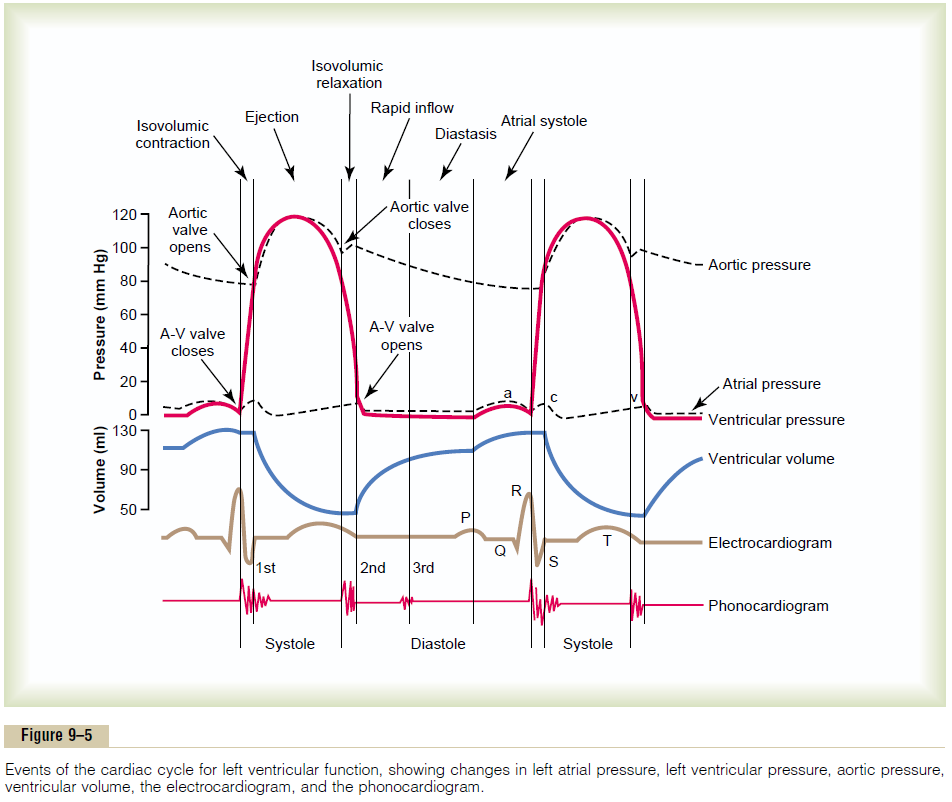Chapter: Medical Physiology: Heart Muscle; The Heart as a Pump and Function of the Heart Valves
Function of the Ventricles as Pumps
Function of the Ventricles as Pumps
Filling of the Ventricles. During ventricular systole, largeamounts of blood accumulate in the right and left atria because of the closed A-V valves. Therefore, as soon as systole is over and the ventricular pressures fall again to their low diastolic values, the moderately increased pressures that have developed in the atria during ventricular systole immediately push the A-V valves open and allow blood to flow rapidly into the ventricles, as shown by the rise of the left ventricularvolume curve in Figure 9–5. This is called the period of rapid filling of the ventricles.

The period of rapid filling lasts for about the first third of diastole. During the middle third of diastole, only a small amount of blood normally flows into the ventricles; this is blood that continues to empty into the atria from the veins and passes through the atria directly into the ventricles.
During the last third of diastole, the atria contract and give an additional thrust to the inflow of blood into the ventricles; this accounts for about 20 per cent of the filling of the ventricles during each heart cycle.
Emptying of the Ventricles During Systole
Period of Isovolumic (Isometric) Contraction. Immedi-ately after ventricular contraction begins, the ventric-ular pressure rises abruptly, as shown in Figure 9–5, causing the A-V valves to close. Then an additional 0.02 to 0.03 second is required for the ventricle to build up sufficient pressure to push the semilunar (aortic and pulmonary) valves open against the pressures in the aorta and pulmonary artery. Therefore, during this period, contraction is occurring in the ventricles, but there is no emptying. This is called the period of iso-volumic or isometric contraction, meaning that tensionis increasing in the muscle but little or no shortening of the muscle fibers is occurring.
Period of Ejection. When the left ventricular pressurerises slightly above 80 mm Hg (and the right ventricu-lar pressure slightly above 8 mm Hg), the ventricular pressures push the semilunar valves open. Immedi-ately, blood begins to pour out of the ventricles, with about 70 per cent of the blood emptying occurring during the first third of the period of ejection and the remaining 30 per cent emptying during the next two thirds. Therefore, the first third is called the period ofrapid ejection, and the last two thirds, the period of slow ejection.
Period of Isovolumic (Isometric) Relaxation. At the end ofsystole, ventricular relaxation begins suddenly, allow-ing both the right and leftintraventricular pressures to decrease rapidly. The elevated pressures in the dis-tended large arteries that have just been filled with blood from the contracted ventricles immediately push blood back toward the ventricles, which snaps the aortic and pulmonary valves closed. For another 0.03 to 0.06 second, the ventricular muscle continues to relax, even though the ventricular volume does not change, giving rise to the period of isovolumic or iso-metric relaxation. During this period, the intraven-tricular pressures decrease rapidly back to their low diastolic levels. Then the A-V valves open to begin a new cycle of ventricular pumping.
End-Diastolic Volume, End-Systolic Volume, and Stroke Volume Output. During diastole, normal filling of the ventriclesincreases the volume of each ventricle to about 110 to 120 milliliters. This volume is called the end-diastolicvolume. Then, as the ventricles empty during systole,the volume decreases about 70 milliliters, which is called the stroke volume output. The remaining volume in each ventricle, about 40 to 50 milliliters, is called the end-systolic volume. The fraction of the end-diastolicvolume that is ejected is called theejection fraction— usually equal to about 60 per cent.
When the heart contracts strongly, the end-systolic volume can be decreased to as little as 10 to 20 milli-liters. Conversely, when large amounts of blood flow into the ventricles during diastole, the ventricular end-diastolic volumes can become as great as 150 to 180 milliliters in the healthy heart. By both increasing the end-diastolic volume and decreasing the end-systolic volume, the stroke volume output can be increased to more than double normal.
Related Topics